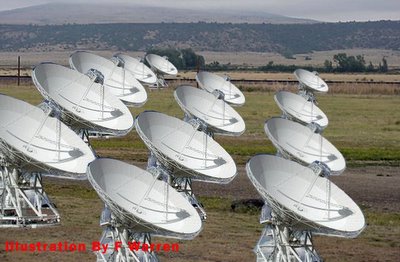
Scientists look for extraterrestrial life
BY BRYN NELSON
Newsday.com
2-21-06
Scientists are ramping up the search for extraterrestrial life with a powerful array of new telescopes and a refined sense of where to look within the vast expanses of our universe.BY BRYN NELSON
Newsday.com
2-21-06
At the annual conference of the American Association for the Advancement of Science last weekend, a panel of experts discussed the key components of life and what it might mean to find them within our own solar system -- or beyond.
Even in the absence of a breakthrough discovery, Nathalie Cabrol of the Mountain View, Calif.-based SETI Institute said such efforts could pay big dividends for thinking about life on an ever-changing Earth.
"It is the way we are going to understand where we are coming from and how we are going to survive as a species," she said. With a growing list of microbes capable of living in Earth's harshest conditions and hints of Earth-like features on Mars and Saturn's moon Titan, "our notion of habitability in our own solar system and the rest of the universe is going to change over time," Cabrol said.
Although NASA's Spirit and Opportunity rovers continue trundling across Mars and gathering evidence that the Red Planet once harbored water, SETI (Search for Extraterrestrial Intelligence) is the only research program looking for life beyond the solar system.
Water, energy and nutrients are considered key elements for a habitable planet. But SETI researchers acknowledged that whether habitable means inhabited is a different question entirely, especially since Earth is the only known example.
Jill Tartar, who heads the Center for SETI Research at the nonprofit institute, put the enormity of the challenge into perspective: 100 billion galaxies are believed to exist, each with 100 billion stars. So far, scientists have detected the presence of about 180 planets in orbit around 147 stars beyond our solar system, though most of them are inhospitable giant balls of gas, akin to Jupiter.
So where to begin?
Margaret Turnbull of the Carnegie Institution of Washington has helped to whittle down a preliminary list of nearly 120,000 stars so her colleagues can focus on the ones best suited for a terrestrial planet.
Among her considerations, Turnbull said a star's solar system should include a "habitable zone" that allows liquid water. Also, a star more than 1.5 times the size of our Sun likely wouldn't live long enough to allow advanced life, and stars younger than 3 billion years likely wouldn't allow enough time for advanced life forms to establish themselves.
After scrutinizing all the candidates, Turnbull ended up with a list of 17,129 stars.
"So we've got our work cut out for us," she said.
One star on her shortlist, named 18 Sco, is a virtual solar twin to the Sun. Another, called 51 Peg, already is known to have a giant gaseous planet akin to Jupiter in its orbit.
To aid in the exhaustive search, SETI is setting up the Allen Telescope Array, a joint project with the Radio Astronomy Laboratory at the University of California at Berkeley.
The northern California-based cluster of 350 radio antennas, slated for completion in June, 2008, will allow astronomers to look for new planets or listen for radio transmissions sent from intelligent civilizations in other solar systems.
Tartar said previous technologies allowed researchers to scan about 1,000 stars over a decade. With the Allen Telescope Array, funded largely by Seattle billionaire Paul Allen, SETI scientists believe they will be able to search at least one million stars in the coming decade.
Other space missions under consideration by NASA could aid the search, but Tartar complained that the space agency's budget proposal for astrobiology in fiscal year 2007 has been cut by 50 percent compared with its 2005 budget, leading to worries that such missions could be delayed indefinitely.
Searches for far smaller signs of life are ongoing as well. Pascale Ehrenfreund of the Leiden Institute of Chemistry in the Netherlands said scientists have identified about 140 kinds of molecules in space -- two-thirds of which include carbon, the common denominator of life on Earth. Carbon chemistry throughout the universe seems to follow the same pathways, she said, leading many scientists to suggest a carbon-focused search for identifying other life forms.
Carol Cleland, a professor of philosophy at the University of Colorado at Boulder, believes that approach may be too narrow, however.
"We should be looking for life as we don't know it," she said, by trying to identify systems that appear similar to those on Earth, but which contain provocative anomalies that might be indicative of wildly different forms of life.
And if scientists are eventually successful? SETI's Margaret Pace said finding even primitive signs of life close to home -- on Mars, for example -- may raise difficult policy questions, an issue she said should be thoroughly discussed beforehand.
"It's sort of like getting a message on your answering machine," she said. We may be able to decide whether to respond to a call from a distant planet, but identifying something alive closer to home will not afford us the same luxury.
Tartar predicted that the search could yield headlines within a few decades, "but we won't know if we've found microbes or mathematicians."
Unlike the movie "Contact," in which Jodie Foster portrays a character loosely based on her, Tartar said her institute will be prepared. "We have champagne on ice," she said, "and they forgot that."
More . . .
See Also: Shostak Responds to Recent "SETI Politics" Article
Home

No comments :
Post a Comment
Dear Contributor,
Your comments are greatly appreciated, and coveted; however, blatant mis-use of this site's bandwidth will not be tolerated (e.g., SPAM etc).
Additionally, healthy debate is invited; however, ad hominem and or vitriolic attacks will not be published, nor will "anonymous" criticisms. Please keep your arguments "to the issues" and present them with civility and proper decorum. -FW